Distinct patterns of neuronal inputs and outputs of the juxtaparaventricular and suprafornical regions of the lateral hypothalamic area in the male rat
- PMID: 20170674
- PMCID: PMC2886810
- DOI: 10.1016/j.brainresrev.2010.02.002
Distinct patterns of neuronal inputs and outputs of the juxtaparaventricular and suprafornical regions of the lateral hypothalamic area in the male rat
Abstract
We have analyzed at high resolution the neuroanatomical connections of the juxtaparaventricular region of the lateral hypothalamic area (LHAjp); as a control and in comparison to this, we also performed a preliminary analysis of a nearby LHA region that is dorsal to the fornix, namely the LHA suprafornical region (LHAs). The connections of these LHA regions were revealed with a coinjection tract-tracing technique involving a retrograde (cholera toxin B subunit) and anterograde (Phaseolus vulgaris leucoagglutinin) tracer. The LHAjp and LHAs together connect with almost every major division of the cerebrum and cerebrospinal trunk, but their connection profiles are markedly different and distinct. In simple terms, the connections of the LHAjp indicate a possible primary role in the modulation of defensive behavior; for the LHAs, a role in the modulation of ingestive behavior is suggested. However, the relation of the LHAjp and LHAs to potential modulation of these behaviors, as indicated by their neuroanatomical connections, appears to be highly integrative as it includes each of the major functional divisions of the nervous system that together determine behavior, i.e., cognitive, state, sensory, and motor. Furthermore, although a primary role is indicated for each region with respect to a particular mode of behavior, intermode modulation of behavior is also indicated. In summary, the extrinsic connections of the LHAjp and LHAs (so far as we have described them) suggest that these regions have a profoundly integrative role in which they may participate in the orchestrated modulation of elaborate behavioral repertoires.
Figures

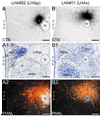
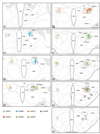























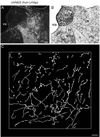
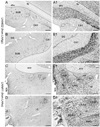
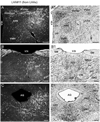
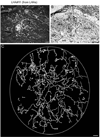

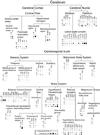

Similar articles
-
Connections of the lateral hypothalamic area juxtadorsomedial region in the male rat.J Comp Neurol. 2012 Jun 15;520(9):1831-90. doi: 10.1002/cne.23064. J Comp Neurol. 2012. PMID: 22488503 Free PMC article.
-
Morphofunctional Organization of the Connections From the Medial and Intermediate Parts of the Central Nucleus of the Amygdala Into Distinct Divisions of the Lateral Hypothalamic Area in the Rat.Front Neurol. 2018 Aug 24;9:688. doi: 10.3389/fneur.2018.00688. eCollection 2018. Front Neurol. 2018. PMID: 30210427 Free PMC article.
-
Organization of connections between the amygdala, medial prefrontal cortex, and lateral hypothalamus: a single and double retrograde tracing study in rats.Brain Struct Funct. 2016 Jul;221(6):2937-62. doi: 10.1007/s00429-015-1081-0. Epub 2015 Jul 14. Brain Struct Funct. 2016. PMID: 26169110 Free PMC article.
-
FoxP2 brainstem neurons project to sodium appetite regulatory sites.J Chem Neuroanat. 2011 Sep;42(1):1-23. doi: 10.1016/j.jchemneu.2011.05.003. Epub 2011 May 13. J Chem Neuroanat. 2011. PMID: 21605659 Free PMC article. Review.
-
An anterograde neuroanatomical tracing method that shows the detailed morphology of neurons, their axons and terminals: Immunohistochemical localization of an axonally transported plant lectin, Phaseolus vulgaris-leucoagglutinin (PHA-L).Brain Res. 2016 Aug 15;1645:42-5. doi: 10.1016/j.brainres.2015.12.040. Epub 2016 Jan 12. Brain Res. 2016. PMID: 26790346 Review.
Cited by
-
Direct hypothalamic and indirect trans-pallidal, trans-thalamic, or trans-septal control of accumbens signaling and their roles in food intake.Front Syst Neurosci. 2015 Feb 13;9:8. doi: 10.3389/fnsys.2015.00008. eCollection 2015. Front Syst Neurosci. 2015. PMID: 25741246 Free PMC article. Review.
-
Hypothalamus-olfactory system crosstalk: orexin a immunostaining in mice.Front Neuroanat. 2012 Nov 8;6:44. doi: 10.3389/fnana.2012.00044. eCollection 2012. Front Neuroanat. 2012. PMID: 23162437 Free PMC article.
-
Hubs and spokes of the lateral hypothalamus: cell types, circuits and behaviour.J Physiol. 2016 Nov 15;594(22):6443-6462. doi: 10.1113/JP271946. Epub 2016 Jul 19. J Physiol. 2016. PMID: 27302606 Free PMC article. Review.
-
Neurochemical characterization of neurons expressing melanin-concentrating hormone receptor 1 in the mouse hypothalamus.J Comp Neurol. 2013 Jul 1;521(10):2208-34. doi: 10.1002/cne.23273. J Comp Neurol. 2013. PMID: 23605441 Free PMC article.
-
Knowledge synthesis with maps of neural connectivity.Front Neuroinform. 2011 Nov 1;5:24. doi: 10.3389/fninf.2011.00024. eCollection 2011. Front Neuroinform. 2011. PMID: 22053155 Free PMC article.
References
-
- Abrahamson EE, Moore RY. The posterior hypothalamic area: chemoarchitecture and afferent connections. Brain Res. 2001;889:1–22. - PubMed
-
- Aggleton JP, Vann SD, Saunders RC. Projections from the hippocampal region to the mammillary bodies in macaque monkeys. Eur J Neurosci. 2005;22:2519–2530. - PubMed
-
- Albert DJ, Chew GL. The septal forebrain and the inhibitory modulation of attack and defense in the rat. A review. Behav Neural Biol. 1980;30:357–388. - PubMed
-
- Alden M, Besson JM, Bernard JF. Organization of the efferent projections from the pontine parabrachial area to the bed nucleus of the stria terminalis and neighboring regions: a PHA-L study in the rat. J Comp Neurol. 1994;341:289–314. - PubMed
Publication types
MeSH terms
Grants and funding
LinkOut - more resources
Full Text Sources

